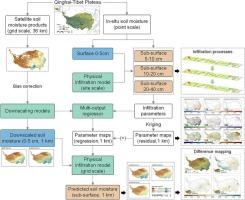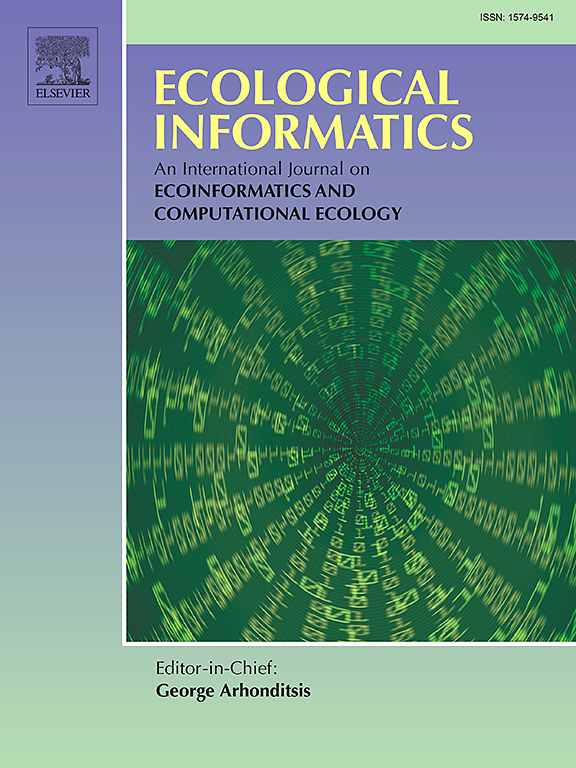Integrating infiltration processes in hybrid downscaling methods to estimate sub-surface soil moisture
IF 5.8
2区 环境科学与生态学
Q1 ECOLOGY
引用次数: 0
Abstract
Soil moisture is a key variable in the water, energy, and carbon cycles. Mapping sub-surface soil moisture with fine spatial resolution requires integrating downscaling approaches and process-based models. However, the effectiveness of hybrid methods, such as regression kriging (RK), in enhancing soil moisture estimates through process-based parameter predictions remains inconclusive. This study aims to integrate infiltration processes into downscaling models to predict 1-km multi-layer soil moisture, while comparing performance of nonlinear and linear models, and evaluating RK improvements. Random forests (RF) and generalized linear model (GLM) were used to downscale surface soil moisture (0–5 cm) from 36-km Soil Moisture Active Passive satellite products to 1 km across the Qinghai-Tibet Plateau. Next, the soil moisture analytical relationship (SMAR) model was applied to simulate infiltration processes and obtain site-scale parameters. RK variants (RFRK and GLMRK) were applied to jointly predict the spatial distribution of multiple infiltration parameters, which were used in SMAR at 1-km grids to estimate sub-surface soil moisture (5–40 cm). The results showed that parameter calibration significantly enhanced sub-surface soil moisture simulation, reducing root mean square error (RMSE) by 61.2 % to 69.8 %, from 0.09 to 0.03. RF outperformed GLM across all depth intervals, providing higher prediction accuracy (average RMSE, RF: 0.07; GLM: 0.09). Moreover, RK enhanced the Nash-Sutcliffe efficiency coefficient (RFRK: 0.34; GLMRK: 0.28) and coefficient of determination (RFRK: 0.5; GLMRK: 0.38) by 7.7 %–13.3 % and 2.2 %–2.4 %. This study provides a reference for mapping multi-layer soil moisture through the integration of data-driven and knowledge-driven approaches in regional-scale study areas.

将渗透过程纳入混合降尺度方法,估算地下土壤湿度
土壤水分是水、能量和碳循环中的一个关键变量。要绘制具有精细空间分辨率的地下土壤水分图,需要将降尺度方法与基于过程的模型相结合。然而,混合方法(如回归克里金法(RK))在通过基于过程的参数预测来提高土壤水分估计值方面的有效性仍无定论。本研究旨在将渗透过程纳入降尺度模型,以预测 1 千米多层土壤水分,同时比较非线性和线性模型的性能,并评估 RK 的改进。使用随机森林(RF)和广义线性模型(GLM)将青藏高原 36 公里土壤水分主动被动卫星产品的表层土壤水分(0-5 厘米)降尺至 1 公里。然后,应用土壤水分分析关系(SMAR)模型模拟入渗过程并获得站点尺度参数。应用 RK 变体(RFRK 和 GLMRK)联合预测多个入渗参数的空间分布,这些参数被用于 SMAR 的 1 千米网格,以估算地下土壤水分(5-40 厘米)。结果表明,参数校准显著增强了次表层土壤水分模拟,将均方根误差(RMSE)从 0.09 降至 0.03,降低了 61.2% 至 69.8%。在所有深度区间,RF 的表现都优于 GLM,预测精度更高(平均均方根误差,RF:0.07;GLM:0.09)。此外,RK 提高了纳什-苏特克利夫效率系数(RFRK:0.34;GLMRK:0.28)和决定系数(RFRK:0.5;GLMRK:0.38),分别为 7.7 %-13.3 % 和 2.2 %-2.4 %。这项研究为在区域尺度研究区域通过数据驱动和知识驱动相结合的方法绘制多层土壤水分图提供了参考。
本文章由计算机程序翻译,如有差异,请以英文原文为准。
求助全文
约1分钟内获得全文
求助全文
来源期刊

Ecological Informatics
环境科学-生态学
CiteScore
8.30
自引率
11.80%
发文量
346
审稿时长
46 days
期刊介绍:
The journal Ecological Informatics is devoted to the publication of high quality, peer-reviewed articles on all aspects of computational ecology, data science and biogeography. The scope of the journal takes into account the data-intensive nature of ecology, the growing capacity of information technology to access, harness and leverage complex data as well as the critical need for informing sustainable management in view of global environmental and climate change.
The nature of the journal is interdisciplinary at the crossover between ecology and informatics. It focuses on novel concepts and techniques for image- and genome-based monitoring and interpretation, sensor- and multimedia-based data acquisition, internet-based data archiving and sharing, data assimilation, modelling and prediction of ecological data.
 求助内容:
求助内容: 应助结果提醒方式:
应助结果提醒方式:


